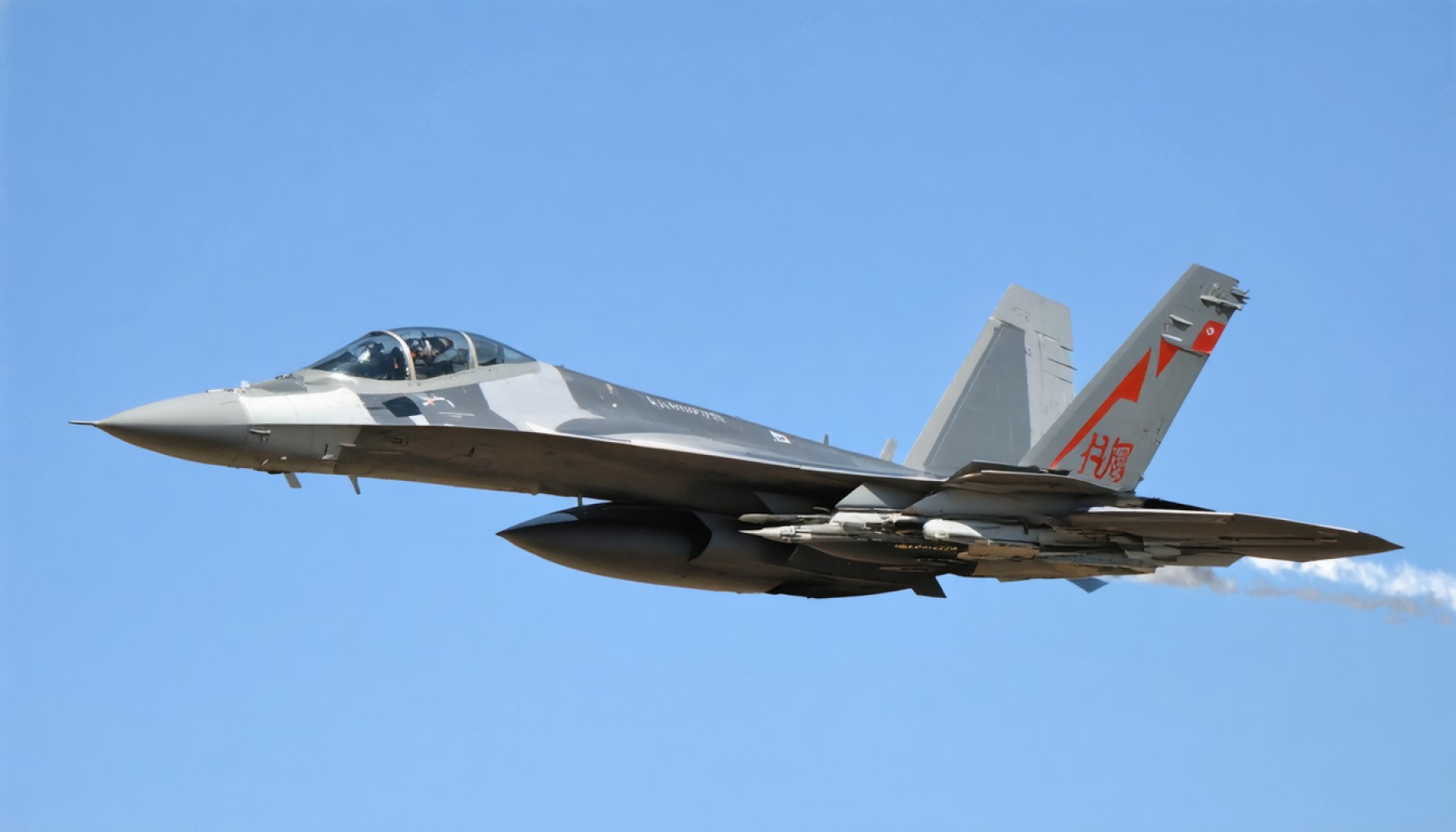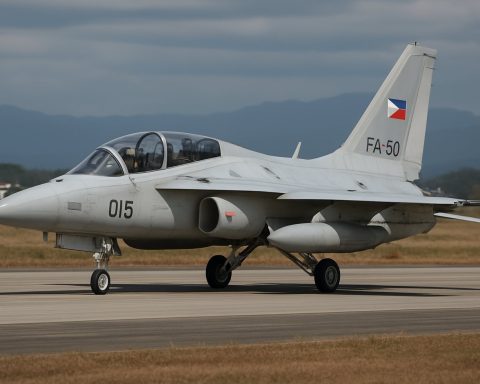- The U.S. Navy’s upcoming F/A-XX fighter promises greater combat range, aiming to revolutionize carrier air wings with nearly a thousand-mile reach.
- This range aims to address the challenge posed by China’s DF-26 anti-ship ballistic missiles, which exceed 3,000 miles.
- The MQ-25 Stingray drone tanker will extend the F/A-XX’s operational range by providing vital in-air refueling.
- The F/A-XX’s design balances carrier constraints with the tactical need for greater endurance and reach.
- While the DF-26 remains a threat, the Navy focuses on alliances and combined operations, emphasizing offensive and defensive strategies.
- The F/A-XX fighter brings tactical agility to carrier-based operations, signaling deterrence and readiness.
- The Navy’s future strategy involves innovation and collaboration to ensure freedom and security in global waters.
Beneath the vast expanse of cobalt blue skies, the U.S. Navy awaits the arrival of its next titan—the F/A-XX fighter—promising a future where carrier air wings can strike deeper into the heart of conflict zones. As promised, this sixth-generation marvel claims a combat range that stretches to nearly a thousand miles, a significant leap from the reign of the F/A-18E/F Super Hornets. However, a larger question looms: is this range enough to thwart China’s strategic might in the Pacific?
China’s People’s Liberation Army Rocket Force casts a long shadow with its formidable DF-26 anti-ship ballistic missiles, prowling the depths of the ocean and possessing a menacing reach of over 3,000 miles. This range dwarfs the nine-hundred fifty-five-mile reach of the F/A-XX, posing a formidable challenge to the Navy’s operational strategies.
Aboard the formidable floating fortress USS John C. Stennis, the dawn of this new era becomes starkly visible. Unlike its land-loving Air Force counterpart, the Navy’s F/A-XX is bound by the unforgiving confines of a carrier’s deck—where every inch matters and fuel tanks cannot afford to grow larger. Here, engineering brilliance intersects with necessity, birthing a fighter that must tread the fine line between design constraints and tactical prowess.
To fortify this ambitious vision, the Navy has set sights on a silent ally in the sky: the MQ-25 Stingray drone tanker. This unmanned sentinel promises to extend the winged reach of the F/A-XX deep into enemy territory, shuttling vital fuel across the skies. Imagine a ballet where graceful metal birds sip from the cup of sustenance, readying themselves for far-reaching sorties. Boasting the capacity to lug 15,000 pounds of fuel, the MQ-25 could stretch the range of fighters like the F-35C by 75%, hinting at a new standard of operational endurance.
However, even with an extended radius, the threat of the DF-26 persists like an ever-changing horizon. This reality necessitates an intricate web of alliances and joint operations. Picture a harmonious concert where land-based cruise missiles and long-range bombers complement the fleet’s endeavors, striking preemptively at missile sites, weaving a tapestry of offensive and defensive strategies.
The F/A-XX fighters, though limited in unrefueled range, bring a unique tactical agility – their presence on the carrier, a symbol of deterrence and rapid response. These futuristic birds in the sky encapsulate the very essence of joint operations—a dance of collaboration ensuring the security of naval assets while projecting power across global waters.
The Navy’s new fighter, the F/A-XX, may not breach the limits of conventional range, but it symbolizes an adaptive force ready to meet the challenges of a modern battlefield. The future of naval aviation is not merely about trumping miles but about orchestrating a symphony of means to secure freedom of the seas. As the Navy endeavors to adapt and thrive, the horizon remains a canvas for innovation, readiness, and strategic resilience.
Can the New F/A-XX Fighter Give the U.S. Navy a Strategic Edge Over China?
The advent of the U.S. Navy’s sixth-generation F/A-XX fighter jet poses intriguing questions about its capabilities, strategic importance, and the challenges it faces in an era of advanced military technology. As naval forces around the world adapt to new threats and technology, the F/A-XX represents a critical development in naval aviation.
Key Features and Innovations of the F/A-XX
The F/A-XX fighter is designed to advance the capabilities of the U.S. Navy as a versatile, next-generation aircraft. Here are some of the notable features:
1. Extended Range: The F/A-XX touts a combat range of approximately 955 miles, significantly enhancing the reach compared to the current F/A-18E/F Super Hornets.
2. MQ-25 Stingray Drone Integration: The MQ-25 provides aerial refueling, considerably boosting operational range and sortie capacity for fighters like the F/A-XX and F-35C by up to 75%.
3. Design Constraints and Adaptations: Operating from aircraft carriers, the F/A-XX is crafted under strict design limitations, balancing fuel capacity and operational performance.
4. Tactical Agility: Despite challenges, its potential rapid response capabilities provide strategic deterrence and defense for naval operations.
Pressing Questions and Controversies
Readers might be curious about whether the F/A-XX can adequately counter existing threats, particularly from China’s military capabilities. Here are insights into these strategic concerns:
– Comparison to Chinese Missile Threats: China’s DF-26 anti-ship missiles have a reported range of over 3,000 miles, surpassing the F/A-XX’s range. This disparity raises questions about how the U.S. Navy plans to mitigate such threats.
– Joint Operations and Alliances: The F/A-XX strategy isn’t just about range but involves mutual operations with allied forces and integrated technology—such as long-range bombers and land-based cruise missiles—to counter potential threats.
Market Trends & Industry Forecast
The defense industry is on the brink of significant advancements with the development of sixth-generation fighters like the F/A-XX. Industry forecasts indicate:
– Increased R&D Investment: Expect substantial investments in R&D as competition heightens for creating more advanced and capable fighter jets.
– Collaborative Defense Initiatives: Global defense alliances stress the importance of collaboration, integrating technology across nations to confront multifaceted threats.
Actionable Recommendations
1. Foster International Defense Alliances: Strengthening alliances and cooperative defense strategies can amplify the effectiveness and reach of the F/A-XX.
2. Utilize Technological Innovations: Embrace future-oriented technologies, including autonomous systems and AI integration, to further bolster tactical capabilities.
3. Integrate Enhanced Defense Systems: Deploy robust missile defense systems to mitigate threats posed by long-range adversarial weaponry like the DF-26.
Quick Tips
– Stay Informed: Keep abreast of developments in military technologies and international military strategies to understand how such innovations affect global security.
– Prioritize Defense Readiness: Continuous training and readiness reviews ensure naval forces remain prepared for a rapidly evolving threat environment.
To explore more about naval developments and strategies, visit the U.S. Navy’s official website.
In conclusion, the F/A-XX represents a pivotal leap in naval aviation technology, yet the path forward will require adaptive strategies, robust alliances, and cutting-edge innovations to maintain security and stability in a challenging global landscape.







